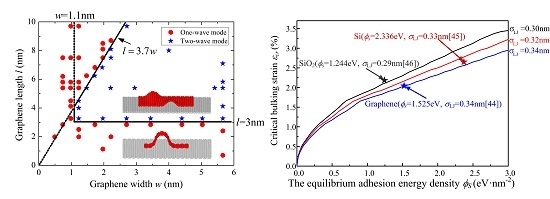Buckling Behavior of Substrate Supported Graphene Sheets
Abstract
:1. Introduction
2. Atomistic Simulation
2.1. Model and Method
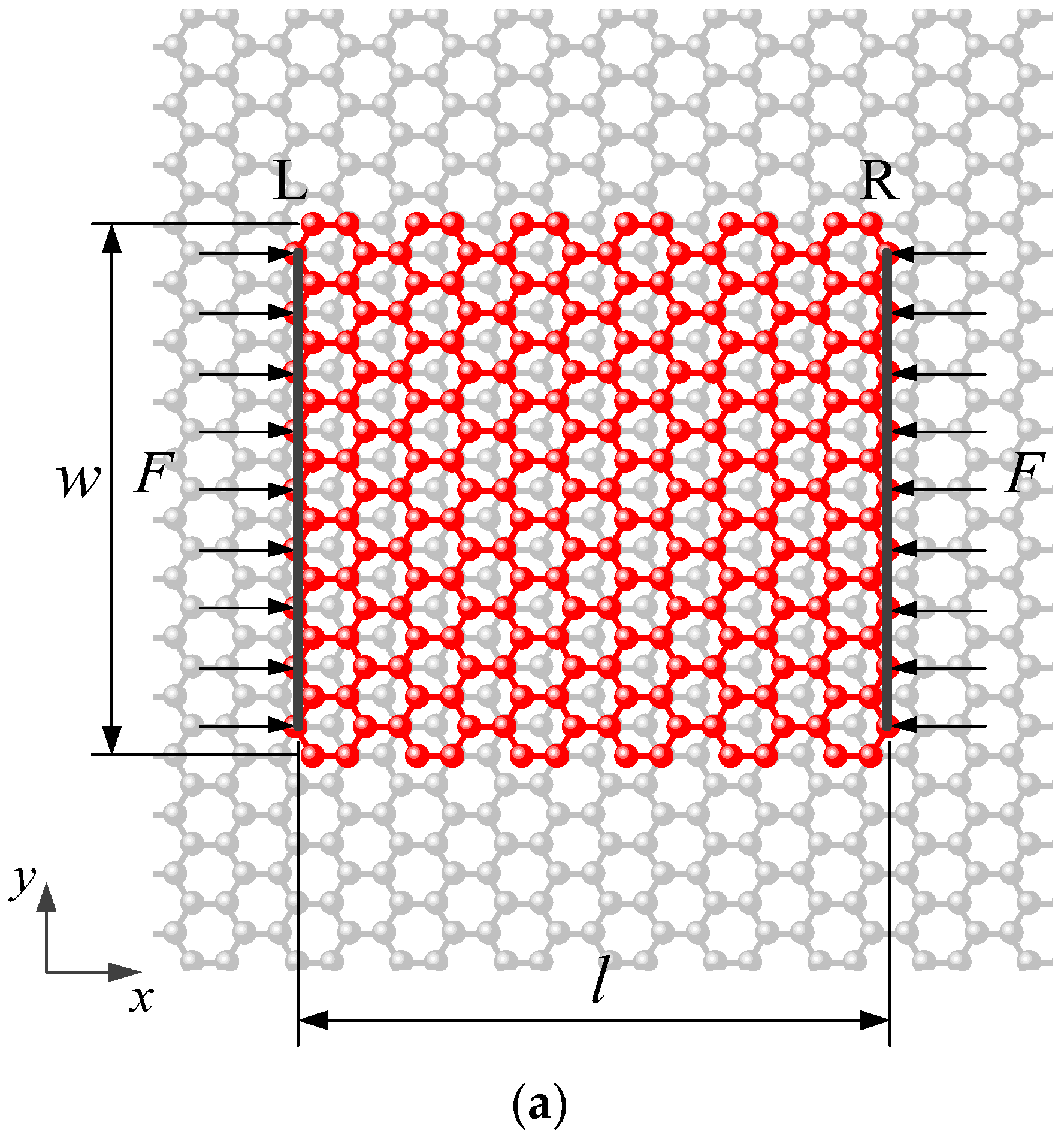
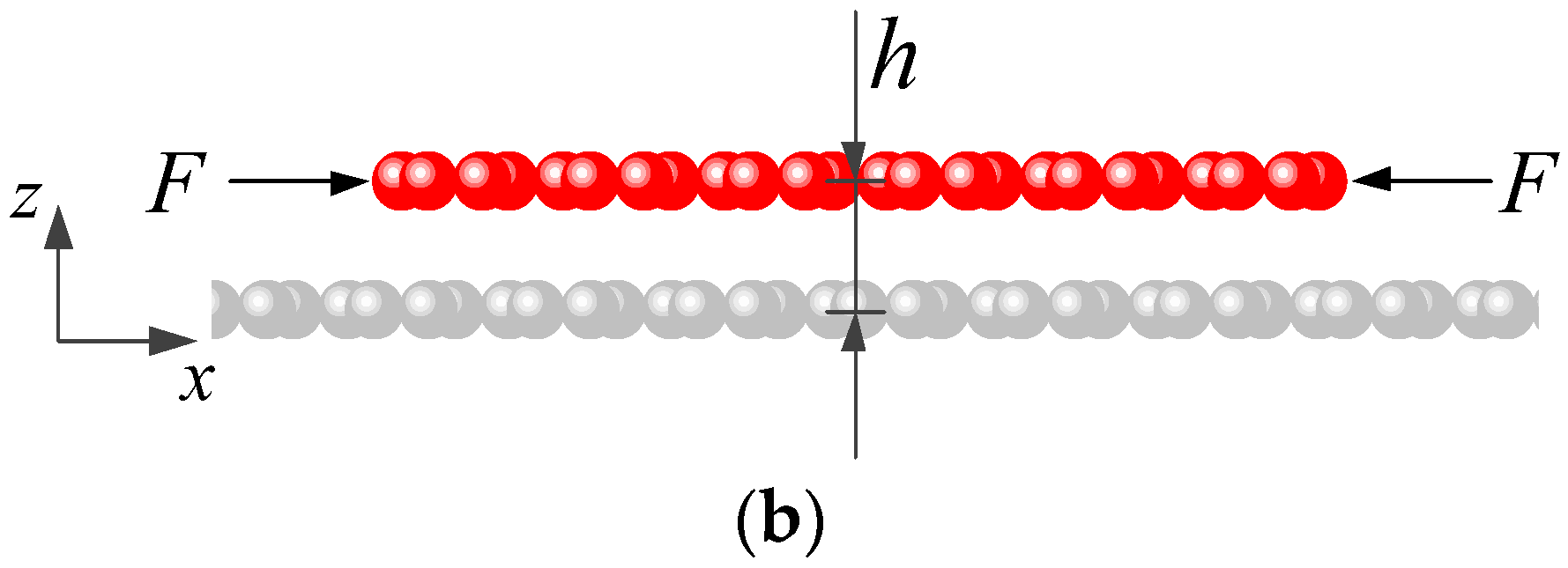
2.2. Buckling and Post-Buckling Process
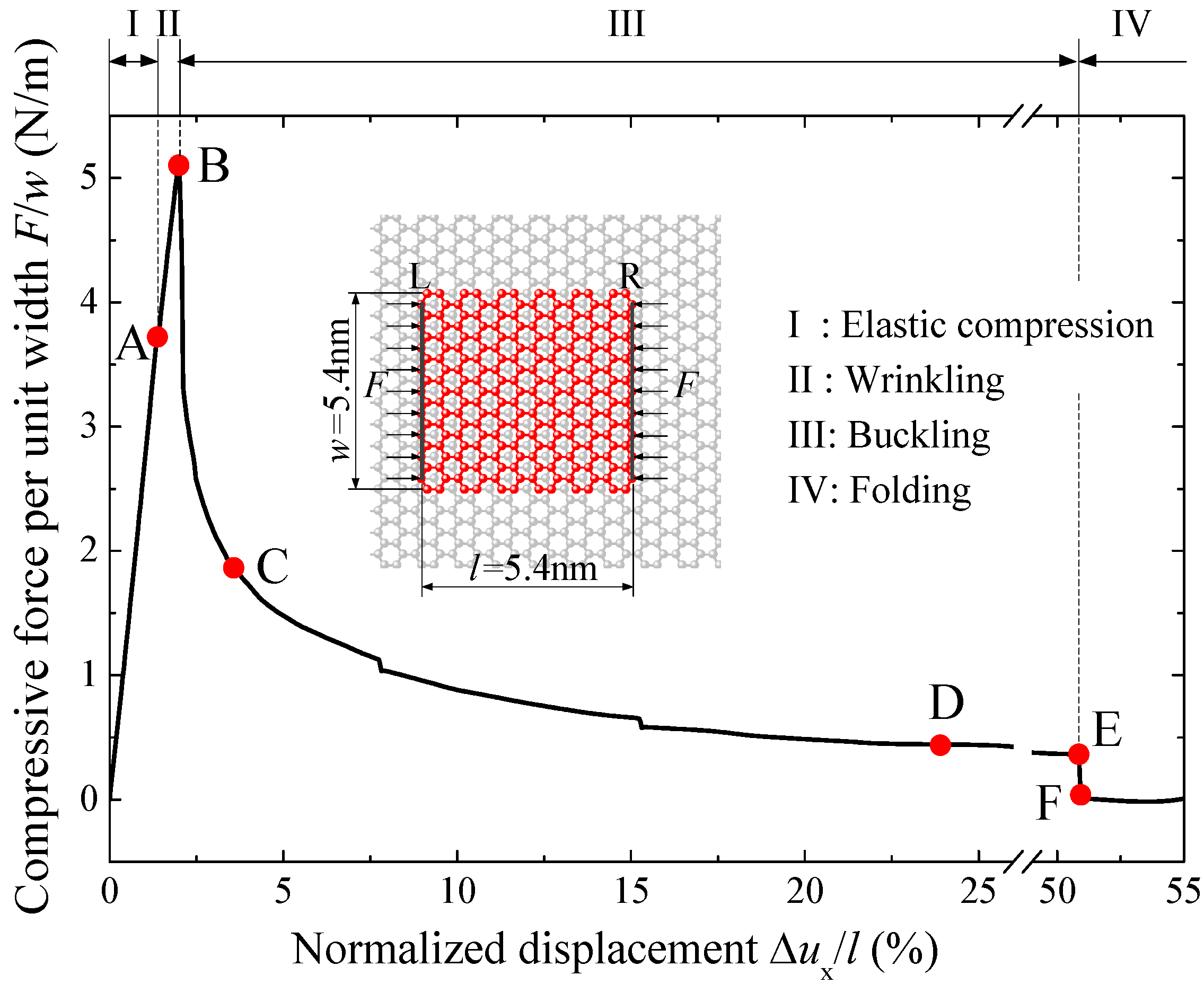
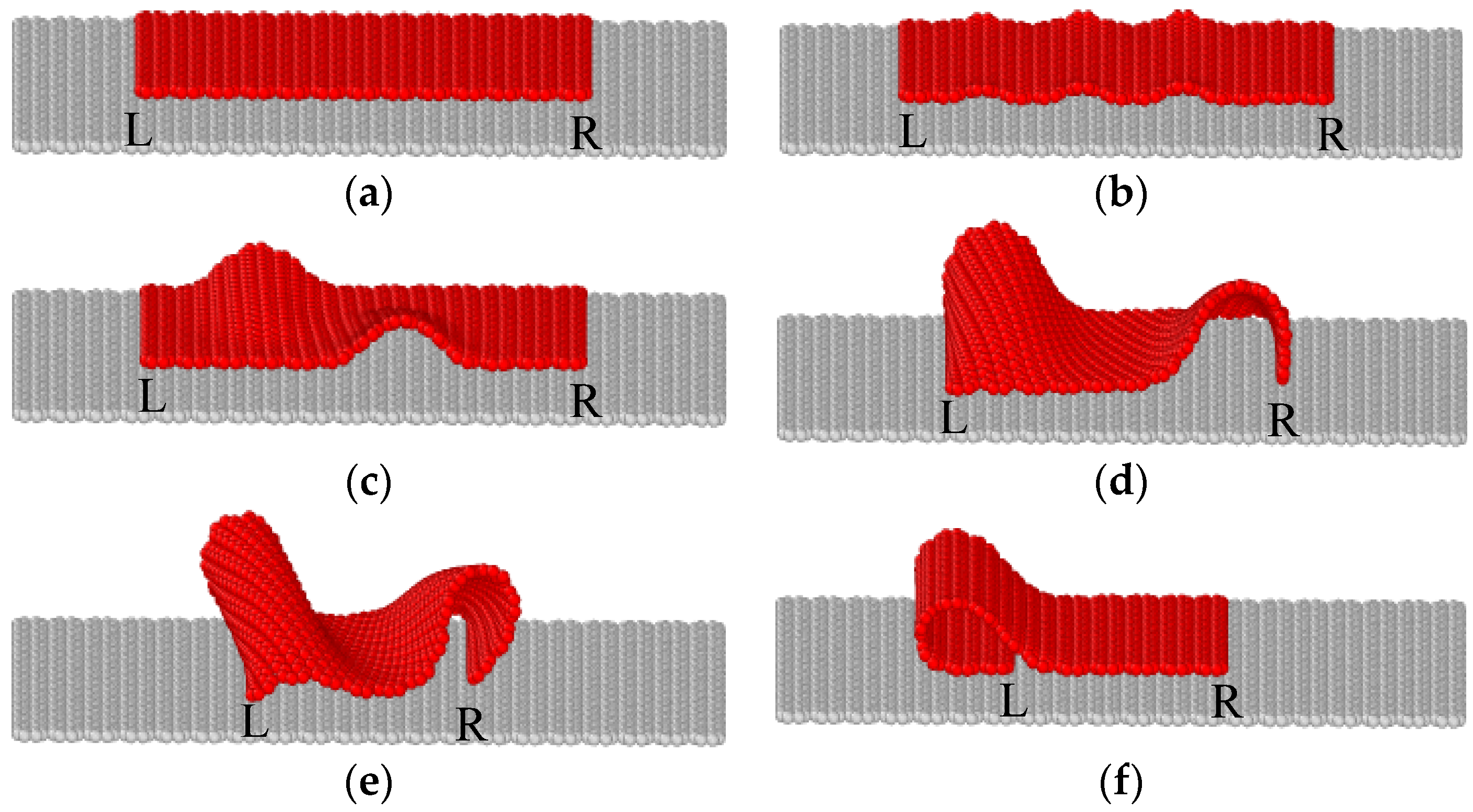
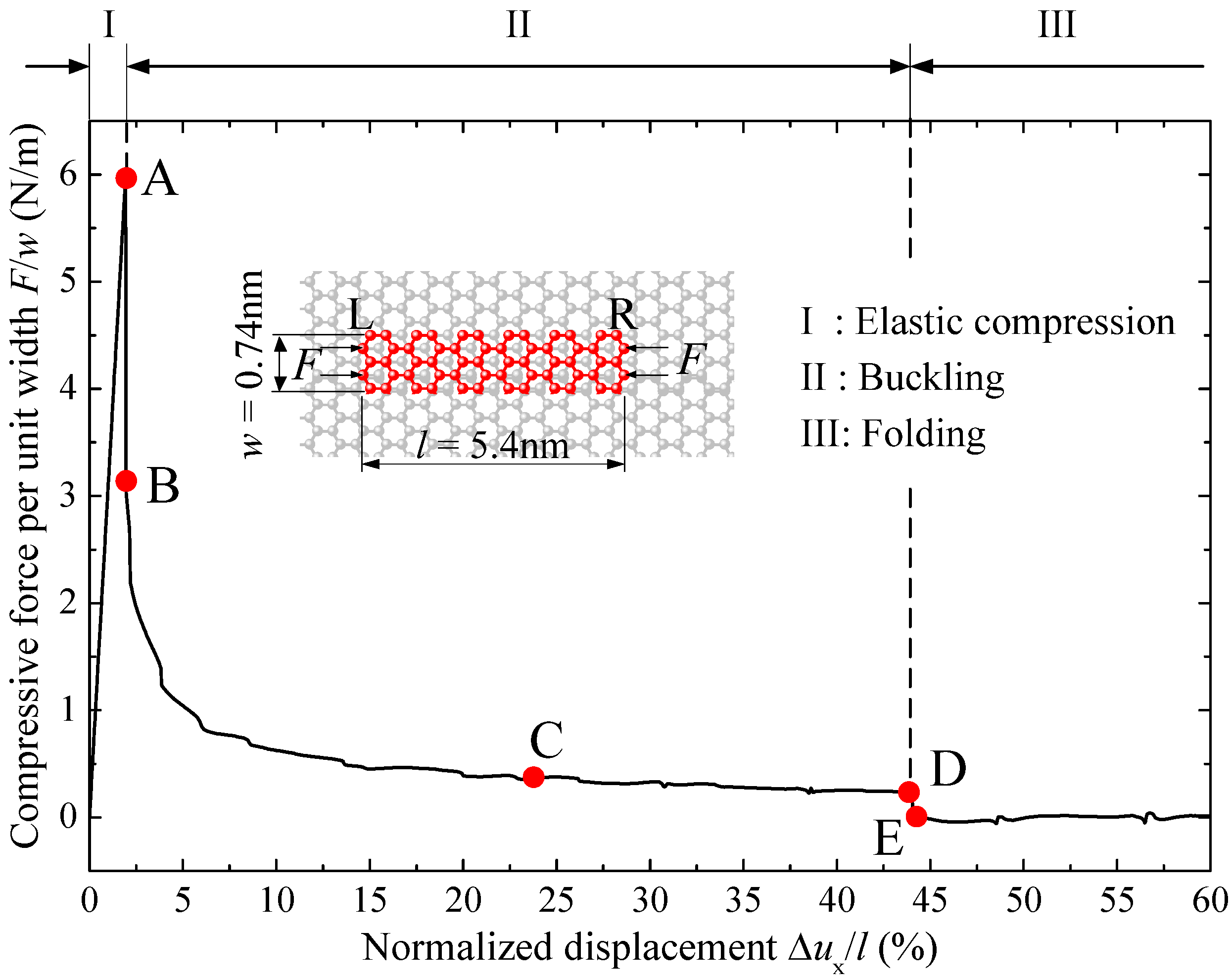
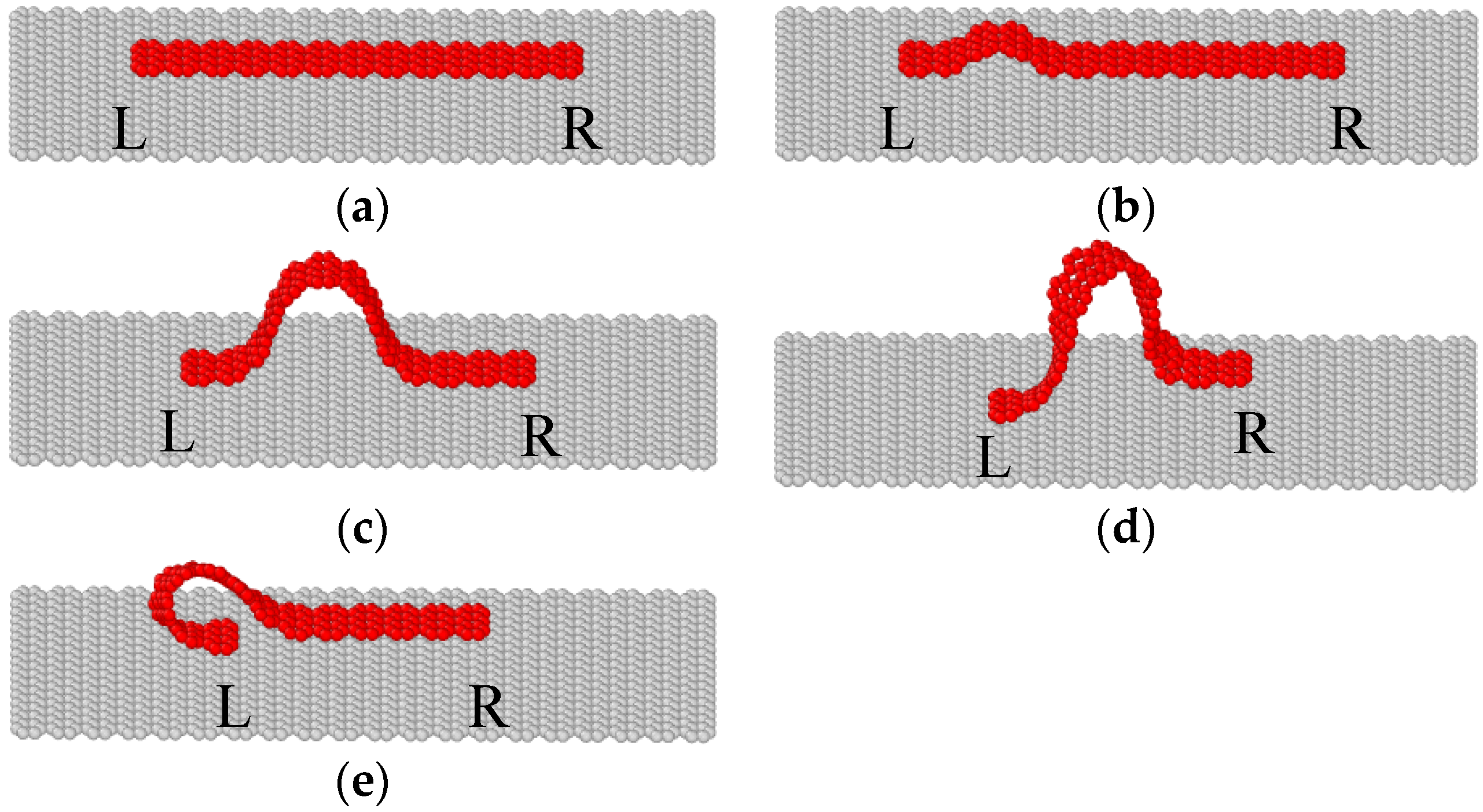
2.3. Buckling Mode
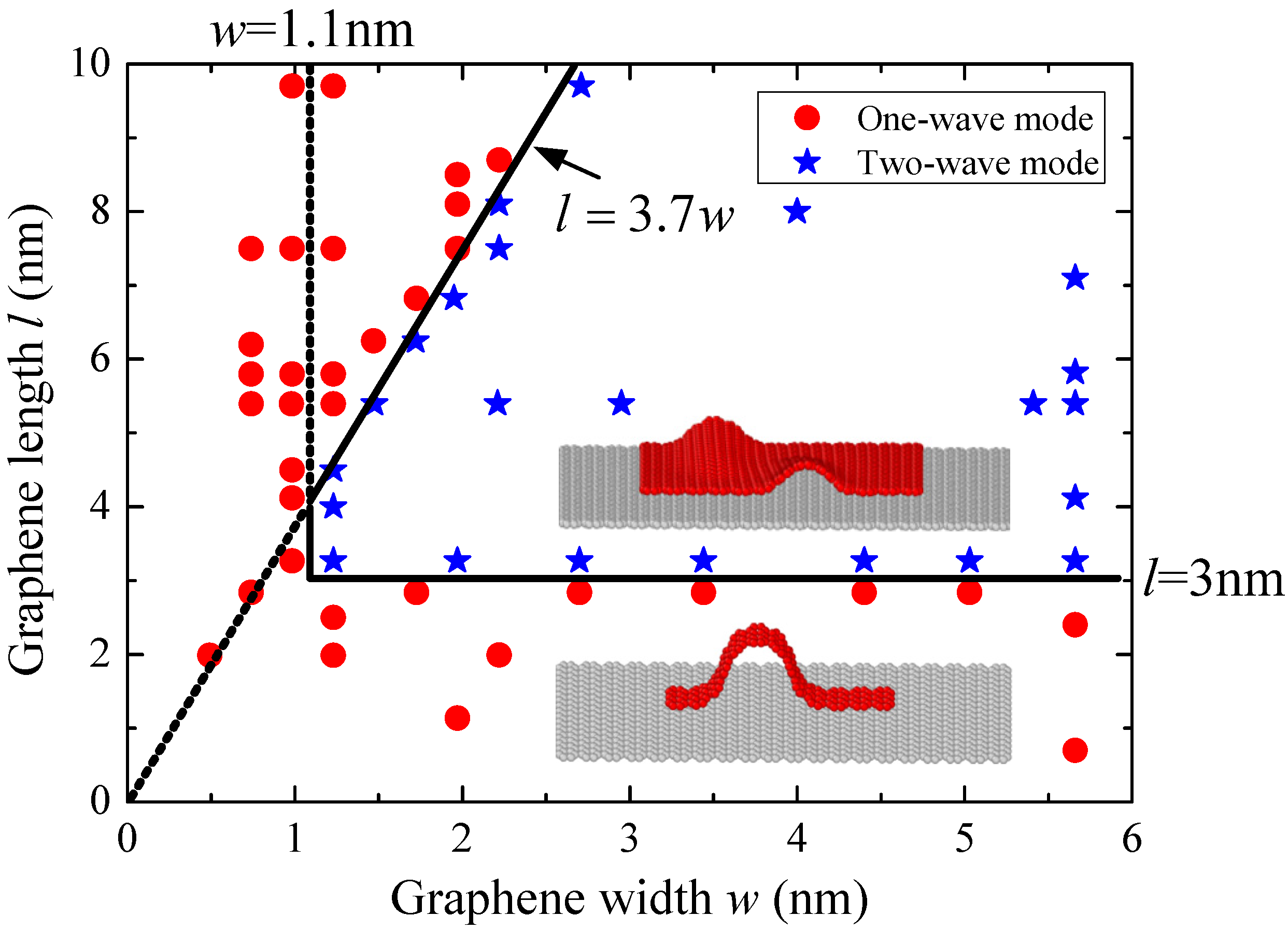
2.4. The Critical Buckling Stress and Strain
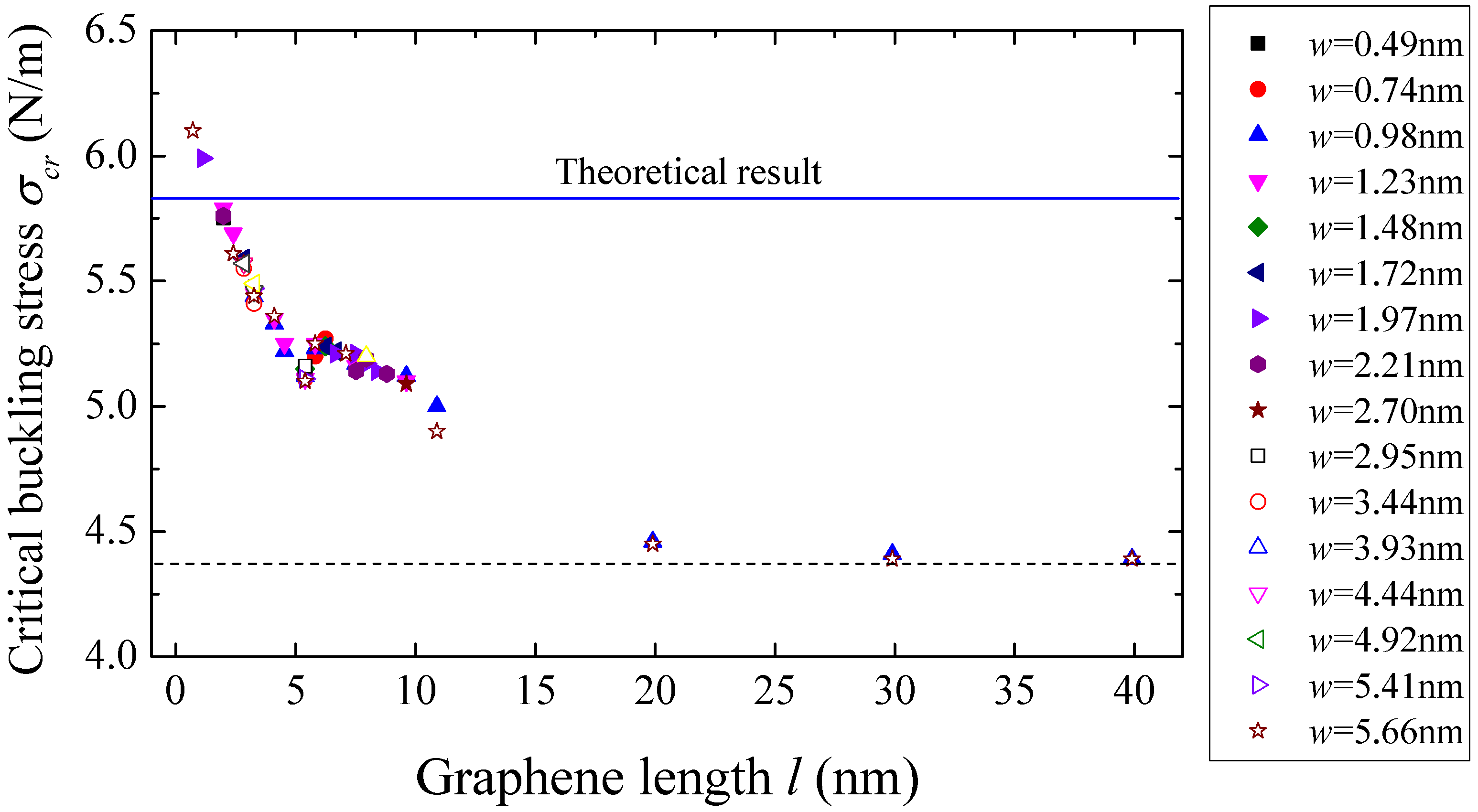
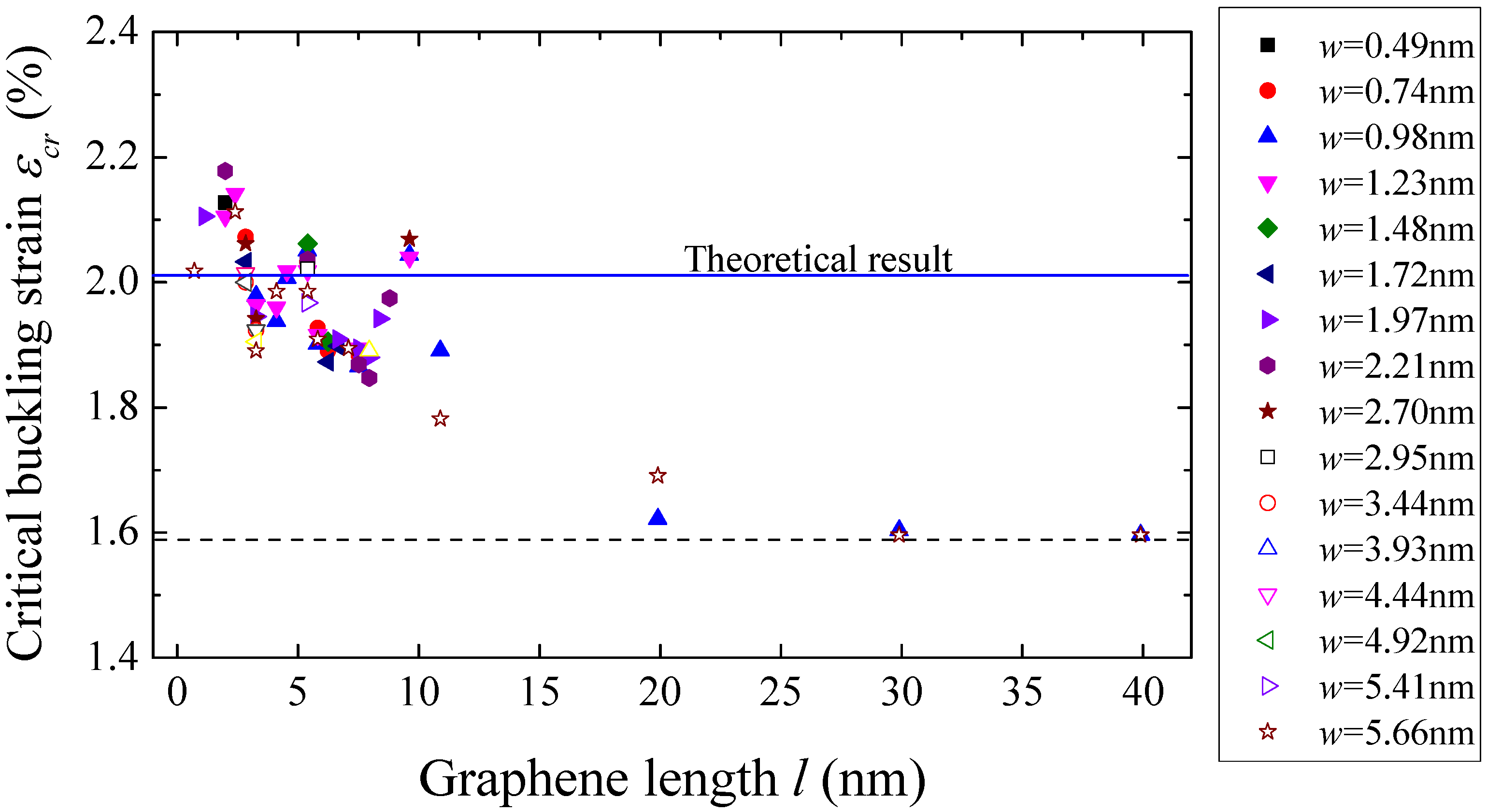
3. Theoretical Analysis
3.1. Energy Analysis
3.2. Numerical Solution
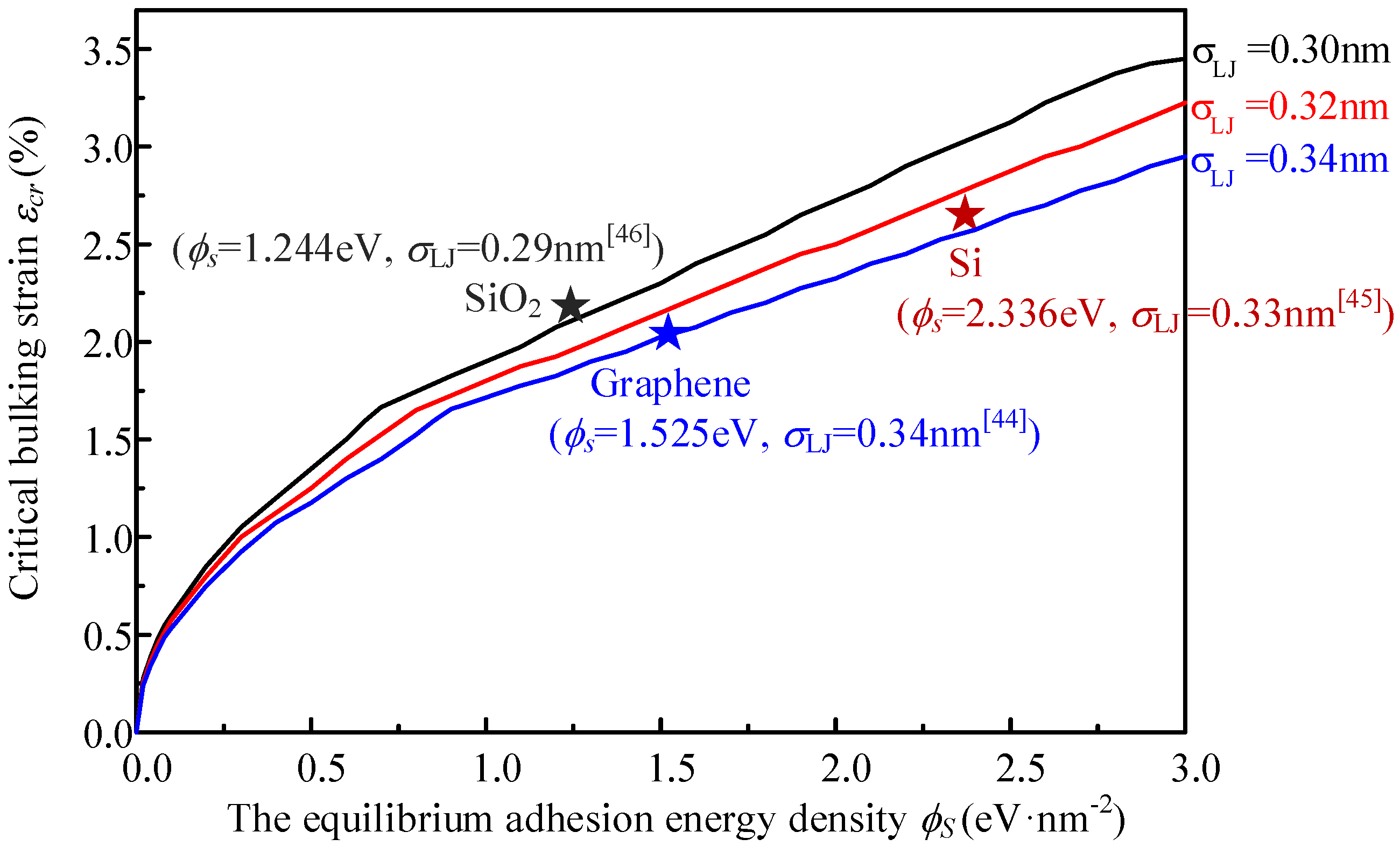
3.3. Analytical Approximate Solution
4. Conclusions
- (1)
- The buckling mode of the simple-supported graphene sheet is dominated by the graphene size. For graphene sheets with length larger than 3 nm and width larger than 1.1 nm, the buckling mode depends on the length/width ratio only.
- (2)
- The critical buckling stress and strain of the substrate-supported graphene sheet with two simple-supported edges are about 4.39 N/m and 1.58%, which are dominated only by the substrate adhesion and independent of the graphene size.
- (3)
- The substrate effect is revealed by both theoretical analysis and atomistic simulation. The critical buckling stress and strain can be increased by increasing the adhesive interaction of substrate. The existence of commonly-used substrates can make the critical buckling stress and strain increased by more than 10 times relative to the free-standing graphene sheets.
Acknowledgments
Author Contributions
Conflicts of Interest
References
- Novoselov, K.S.; FalKo, V.I.; Colombo, L.; Gellert, P.R.; Schwab, M.G.; Kim, K.A. A roadmap for graphene. Nature 2012, 490, 192–200. [Google Scholar] [CrossRef] [PubMed]
- Rao, C.N.R.; Sood, A.K.; Subrahmanyam, K.S.; Govindaraj, A. Graphene: The new two-dimensional nanomaterial. Angew. Chem. 2009, 48, 7752–7777. [Google Scholar] [CrossRef] [PubMed]
- Tkachev, S.V.; Buslaeva, E.Y.; Gubin, S.P. Graphene: A novel carbon nanomaterial. Inorg. Mater. 2011, 47, 1–10. [Google Scholar] [CrossRef]
- Feng, X.; Narita, A. Graphene Nanoribbons. In Encyclopedia of Polymeric Nanomaterials; Springer-Verlag: Berlin, Germany; Heidelberg, Germany, 2014. [Google Scholar]
- Otsuji, T.; Suemitsu, M.; Ryzhii, V. Graphene materials and devices for terahertz science and technology. In Proceedings of the 2013 Asia-Pacific Microwave Conference Proceedings (APMC), Seoul, Korea, 5–8 November 2013; pp. 515–517.
- Xu, G.Y.; Abbott, J.; Qin, L.; Yeung, K.Y.M.; Song, Y.; Yoon, H. Electrophoretic and field-effect graphene for all-electrical DNA array technology. Nat. Commun. 2014, 5, 4866. [Google Scholar] [CrossRef] [PubMed]
- Echtermeyer, T.J.; Lemme, M.C.; Baus, M.; Szafranek, B.N.; Geim, A.K.; Hurz, H. Nonvolatile switching in graphene field-effect devices. IEEE Electron Device Lett. 2008, 29, 952–954. [Google Scholar] [CrossRef]
- Adán-Más, A.; Wei, D. Photoelectrochemical properties of graphene and its derivatives. Nanomaterials 2013, 3, 325–356. [Google Scholar] [CrossRef]
- Parashar, A.; Mertiny, P. Representative volume element to estimate buckling behavior of graphene/polymer nanocomposite. Nanoscale Res. Lett. 2012, 7, 1–6. [Google Scholar] [CrossRef] [PubMed]
- Ansari, R.; Shahabodini, A.; Alipour, A.; Rouhi, H. Stability of a single-layer graphene sheet with various edge conditions: A non-local plate model including interatomic potentials. Proc. Inst. Mech. Eng. N J. Nanoeng. Nanosyst. 2012, 226, 51–60. [Google Scholar] [CrossRef]
- Ansari, R.; Sahmani, S. Prediction of biaxial buckling behavior of single-layered graphene sheets based on nonlocal plate models and molecular dynamics simulations. Appl. Math. Modell. 2013, 37, 7338–7351. [Google Scholar] [CrossRef]
- Ansari, R.; Shahabodini, A.; Rouhi, H. Prediction of the biaxial buckling and vibration behavior of graphene via a nonlocal atomistic-based plate theory. Compos. Struct. 2013, 95, 88–94. [Google Scholar] [CrossRef]
- Omer, C. Elastic buckling behavior of skew shaped single-layer graphene sheets. Thin Solid Films 2014, 550, 450–458. [Google Scholar]
- Farajpour, A.; Solghar, A.A.; Shahidi, A. Postbuckling analysis of multi-layered graphene sheets under non-uniform biaxial compression. Physica E 2013, 47, 197–206. [Google Scholar] [CrossRef]
- Shi, J.X.; Ni, Q.Q.; Lei, X.W.; Natsuki, T. Nonlocal elasticity theory for the buckling of double-layer graphene nanoribbons based on a continuum model. Comput. Mater. 2011, 50, 3085–3090. [Google Scholar] [CrossRef]
- Pradhan, S.C.; Murmu, T. Small scale effect on the buckling of single-layered graphene sheets under biaxial compression via nonlocal continuum mechanics. Comput. Mater. Sci. 2009, 47, 268–274. [Google Scholar] [CrossRef]
- Natsuki, T.; Shi, J.X.; Ni, Q.Q. Buckling instability of circular double-layered graphene sheets. J. Phys. Condens. Matter 2012, 24, 135004–135008. [Google Scholar] [CrossRef] [PubMed]
- Wang, L.; Zhang, Q. Elastic behavior of bilayer graphene under in-plane loadings. Curr. Appl. Phys. 2012, 12, 1173–1177. [Google Scholar] [CrossRef]
- Anjomshoa, A.; Shahidi, A.R.; Hassani, B.; Jomehzadeh, E. Finite element buckling analysis of multi-layered graphene sheets on elastic substrate based on nonlocal elasticity theory. Appl. Math. Modell. 2014, 38, 5934–5955. [Google Scholar] [CrossRef]
- Wang, G.; Liu, L.; Dai, Z.; Liu, Q.; Miao, H.; Zhang, Z. Biaxial compressive behavior of embedded monolayer graphene inside flexible poly(methyl methacrylate) matrix. Carbon 2015, 86, 69–77. [Google Scholar] [CrossRef]
- Jiang, T.; Huang, R.; Zhu, Y. Interfacial sliding and buckling of monolayer graphene on a stretchable substrate. Adv. Funct. Mater. 2014, 24, 396–402. [Google Scholar] [CrossRef]
- Wilber, J.P. Buckling of graphene layers supported by rigid substrates. J. Comput. Theor. Nanosci. 2010, 7, 2338–2348. [Google Scholar] [CrossRef]
- Pablo, M.; Martin, S.; Pinardi, A.L.; Gonzalo, O.; Martin-gago, J.A. Strain-driven moire’ superstructures of epitaxial graphene on transition metal surfaces. ACS Nano 2011, 5, 5627–5634. [Google Scholar]
- N’Diaye, A.T.; Gastel, R.V.; Martinez-Galera, A.J.; Coraux, J.; Hattab, H.; Wall, D. In situ observation of stress relaxation in epitaxial graphene. New J. Phys. 2009, 11. [Google Scholar] [CrossRef]
- Zhou, Y.; Chen, Y.; Liu, B.; Wang, S.; Yang, Z.; Hu, M. Mechanics of nanoscale wrinkling of graphene on a non-developable surface. Carbon 2015, 84, 263–271. [Google Scholar] [CrossRef]
- Liu, B.; Huang, Y.; Jiang, H.; Qu, S.; Hwang, K.C. The atomic-scale finite element method. Comput. Methods Appl. Mech. Engrg. 2004, 193, 1849–1864. [Google Scholar] [CrossRef]
- Liu, B.; Jiang, H.; Huang, Y.; Qu, S.; Yu, M.F.; Huang, K.C. Atomic-scale finite element method in multiscale computation with applications to carbon nanotubes. Phys. Rev. B 2005, 72. [Google Scholar] [CrossRef]
- Guo, X.; Leung, A.; He, X.Q.; Jiang, H.; Huang, Y. Bending buckling of single-walled carbon nanotubes by atomic-scale finite element. Compos. B Eng. 2008, 39, 202–208. [Google Scholar] [CrossRef]
- Chen, Y.L.; Liu, B.; Wu, J.; Huang, Y.; Jiang, H.; Hwang, K.C. Mechanics of hydrogen storage in carbon nanotubes. J. Mech. Phys. Solids 2008, 56, 3224–3241. [Google Scholar] [CrossRef]
- Chen, Y.L.; Liu, B.; He, X.Q.; Huang, Y.; Hwang, K.C. Failure analysis and the optimal toughness design of carbon nanotube-reinforced composites. Compos. Sci. Technol. 2010, 70, 1360–1367. [Google Scholar] [CrossRef]
- Chen, Y.L.; Liu, B.; Hwang, K.C.; Huang, Y. A theoretical evaluation of load transfer in multi-walled carbon nanotubes. Carbon 2011, 49, 193–197. [Google Scholar] [CrossRef]
- Brenner, D.W.; Shenderova, O.A.; Harrison, J.A.; Stuart, S.J.; Ni, B.; Sinnott, S.B. A second-generation reactive empirical bond order (REBO) potential energy expression for hydrocarbons. J. Phys. Condens. Matter 2002, 14, 783–802. [Google Scholar] [CrossRef]
- Mandel, F.; Bearman, R.J.; Bearman, M.Y. Numerical solutions of the Percus-Yevick equation for the Lennard-Jones (6–12) and hard-sphere potentials. J. Chem. Phys. 1970, 52, 3315–3323. [Google Scholar] [CrossRef]
- Chong, G.; Gao, G.H.; Yu, Y.X.; Mao, Z.Q. Simulation study of hydrogen storage in single walled carbon nanotubes. Int. J. Hydrog. Energy 2001, 26, 691–696. [Google Scholar]
- Lu, W.B.; Wu, J.; Jiang, L.Y.; Huang, Y.; Hwang, K.C.; Liu, B. A cohesive law for multi-wall carbon nanotubes. Philos. Mag. 2007, 87, 2221–2232. [Google Scholar] [CrossRef]
- Koskinen, P. Graphene cardboard: From ripples to tunable metamaterial. Appl. Phys. Lett. 2014, 104, 101902–101904. [Google Scholar] [CrossRef]
- Lu, Z.; Dunn, M.L. Van der Waals adhesion of graphene membranes. J. Appl. Phys. 2010, 107, 044301–044305. [Google Scholar] [CrossRef]
- Cranford, S.W. Buckling induced delamination of graphene composites through hybrid molecular modeling. Appl. Phys. Lett. 2013, 102, 031902–031905. [Google Scholar] [CrossRef]
- Landau, L.D.; Lifshitz, E.M. Theory of Elasticity; Springer: Berlin,Germany; Heidelberg, Germany, 1959; Volume 42, pp. 580–582. [Google Scholar]
- Zhang, K.; Arroyo, M. Adhesion and friction control localized folding in supported graphene. J. Appl. Phys. 2013, 113, 193501–193508. [Google Scholar] [CrossRef]
- Ramasubramaniam, A.; Koskinen, P.; Kit, O.O.; Shenoy, V.B. Edge-stress-induced spontaneous twisting of graphene nanoribbons. J. Appl. Phys. 2012, 111, 054302–054305. [Google Scholar] [CrossRef]
- Shenoy, V.B.; Reddy, C.D.; Ramasubramaniam, A.; Zhang, Y.W. Edge-stress-induced warping of graphene sheets and nanoribbons. Phys. Rev. Lett. 2008, 101, 3382–3390. [Google Scholar] [CrossRef] [PubMed]
- Huang, B.; Liu, M.; Su, N.; Wu, J.; Duan, W.; Gu, B.; Liu, F. Quantum manifestations of graphene edge stress and edge instability: A first-principles study. Phys. Rev. Lett. 2009, 102. [Google Scholar] [CrossRef] [PubMed]
- Girifalco, L.A.; Hodak, M.; Lee, R.S. Carbon nanotubes, buckyballs, ropes, and a universal graphitic potential. Phys. Rev. B 2000, 62, 13104–13110. [Google Scholar] [CrossRef]
- Ong, Z.Y.; Pop, E. Molecular dynamics simulation of thermal boundary conductance between carbon nanotubes and SiO2. Phys. Rev. B 2010, 81. [Google Scholar] [CrossRef]
- Neek-Amal, M.; Peeters, F.M. Strain-engineered graphene through a nanostructured substrate. I. Deformations. Phys. Rev. B 2012, 85, 2202–2208. [Google Scholar] [CrossRef]
- Kerszberg, N.; Suryanarayana, P. Ab initio strain engineering of graphene: Opening bandgaps up to 1 eV. Rsc Adv. 2015, 5, 43810–43814. [Google Scholar] [CrossRef]
- Pereira, V.M.; Neto, A.H.C. Strain engineering of graphene’s electronic structure. Phys. Rev. Lett. 2009, 103. [Google Scholar] [CrossRef] [PubMed]
- Wang, Y.; Yang, R.; Shi, Z.; Zhang, L.; Shi, D.; Wang, E.; Zhang, G. Super-elastic graphene ripples for flexible strain sensors. Acs Nano 2011, 5, 3645–3650. [Google Scholar] [CrossRef] [PubMed]
© 2016 by the authors; licensee MDPI, Basel, Switzerland. This article is an open access article distributed under the terms and conditions of the Creative Commons by Attribution (CC-BY) license (http://creativecommons.org/licenses/by/4.0/).
Share and Cite
Yang, K.; Chen, Y.; Pan, F.; Wang, S.; Ma, Y.; Liu, Q. Buckling Behavior of Substrate Supported Graphene Sheets. Materials 2016, 9, 32. https://doi.org/10.3390/ma9010032
Yang K, Chen Y, Pan F, Wang S, Ma Y, Liu Q. Buckling Behavior of Substrate Supported Graphene Sheets. Materials. 2016; 9(1):32. https://doi.org/10.3390/ma9010032
Chicago/Turabian StyleYang, Kuijian, Yuli Chen, Fei Pan, Shengtao Wang, Yong Ma, and Qijun Liu. 2016. "Buckling Behavior of Substrate Supported Graphene Sheets" Materials 9, no. 1: 32. https://doi.org/10.3390/ma9010032
APA StyleYang, K., Chen, Y., Pan, F., Wang, S., Ma, Y., & Liu, Q. (2016). Buckling Behavior of Substrate Supported Graphene Sheets. Materials, 9(1), 32. https://doi.org/10.3390/ma9010032




